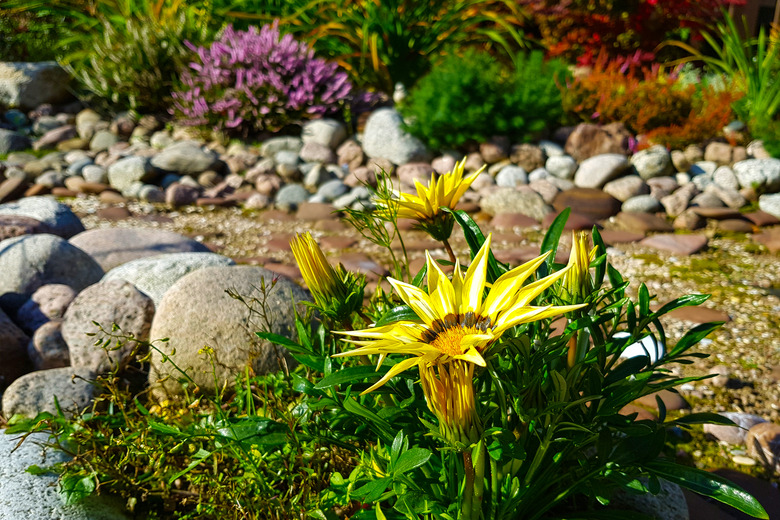How To Use Rocks In Drainage Ditches
Drainage ditches have one primary purpose: to carry water from one place to another. Using rocks for drainage helps control the flow of water and prevent erosion on sloping lots and alongside driveways and roads. Ditches can be utilitarian or decorative as well as practical features of a landscape. Choosing the right rocks for the job is an important part of a successful drainage system.
Drainage Ditch Rocks
The type of rock used in drainage ditches varies depending on the purpose and aesthetics. Riprap is rock used to cover the soil along the sides and bottom and may be used to fill the entire ditch. These rough-sided stones range in size all the way up to 2 cubic feet. The steeper the slope, the larger the rocks should be in order to resist tumbling down the hillside with the flow of stormwater as it runs through the ditch.
Drain rock, or crushed gravel, ranges from 3/8 inch up to 1 1/2 inches or more depending on local suppliers and the quarry where it was excavated. It may be used as a base under driveways and pathways as well as a water-permeable inorganic mulch in the garden.
River rocks are 3/4- to 2-inch or larger rounded rocks often used as the decorative element in the landscape, from edging flowerbeds to covering bare soil around trees, shrubs, and other plants. These stones provide a visual expression of water in a dry creek. Larger rocks or boulders can be used as focal points in the garden or to slow the flow of stormwater in the landscape.
Utilitarian Drainage Ditches
Drainage ditches along roads and through rural properties are utilitarian, but they don't have to be ugly. If possible, a ditch designed to carry away stormwater should be twice as wide as deep to not only move the water but to also give it room to spread out and soak into the surrounding soil. Add drain rock and compact it into the bottom and sides of the ditch to help hold the soil in place. Alternatively, partially fill the ditch with riprap to slow the flow of water and help reduce erosion.
Drainage in the Landscape
French drains are one method of controlling water in the landscape while avoiding open ditches. A French drain is a narrow, deep trench with a perforated pipe at the bottom. In general, the ditch is lined with a geotextile or landscape fabric and then a layer of drain rock or gravel is added to cover the bottom. The pipe is installed with the perforations down and is covered with more gravel. Then a few inches of soil and sod are laid over the top to hide the ditch.
An alternative to a French drain is a narrow ditch installed next to a driveway to drain stormwater running off the hardscape. The ditch may be lined with concrete or filled with gravel and topped with river rock or a decorative grate.
Dry Creeks and Decorative Ditches
Dry creeks, rain gardens, and Zen gardens are also ways to incorporate a ditch as a landscape feature. A dry creek wanders across the garden and is lined with landscape fabric. Using river rocks for drainage adds to the illusion of water flowing in summer and slows stormwater during the rainy season. Water-loving plants planted alongside the creek bed, such as iris and cannas, soften the edges of the rocky watercourse.
A rain garden is another option at the beginning or end of a dry creek or as a standalone focal point. Usually planted in a low spot, a rain garden incorporates gravel for drainage, decorative or river rock as mulch or a border, and plants that thrive in moist to wet conditions.
Alternatively, a Zen or desert garden can fulfill multiple functions in the landscape. French drains, shallow swales, or low-sided ditches covered with gravel, river rocks, and boulders move water away from your home and other structures. Whether you choose to plant a flowering cherry tree, Japanese maple, conifers and other shrubs, or a variety of succulents and cacti, the gravel-covered landscape provides an eye-catching and easy-care garden.
